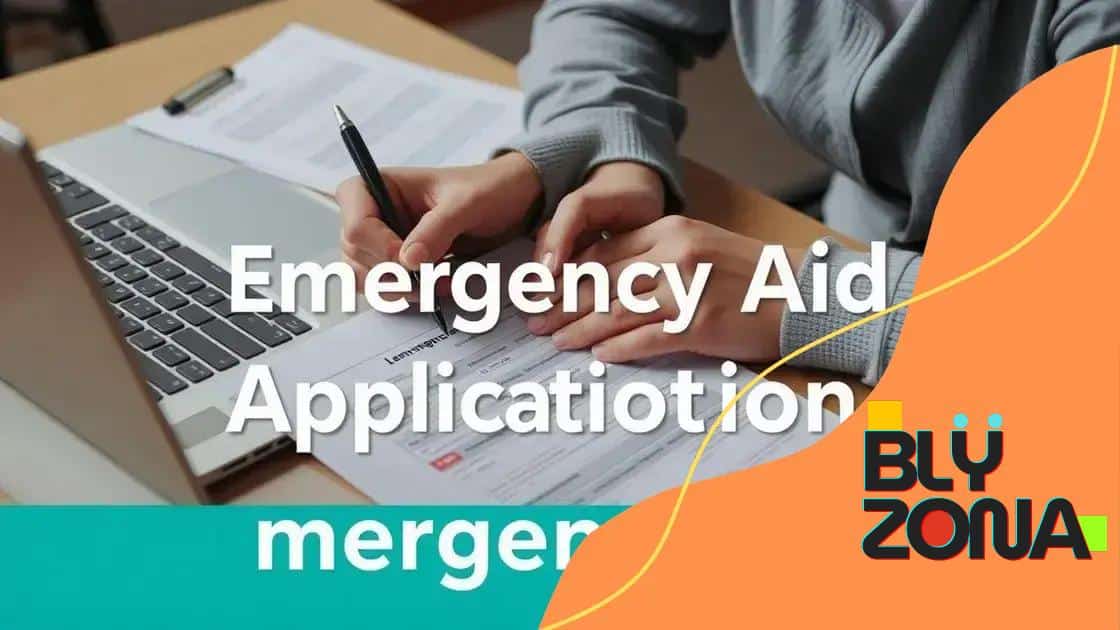Emergency financial aid during economic crises: what you need to know

Emergency financial aid during economic crises includes government assistance, nonprofit grants, and community support, providing vital resources to individuals and families facing unexpected financial hardships.
Emergency financial aid during economic crises plays a crucial role in helping individuals and communities regain stability. Have you ever wondered how these funds can help in tough times? Let’s delve deeper into this important topic.
Understanding emergency financial aid
Understanding emergency financial aid is essential during tough economic times. This aid can help you cover unexpected expenses and keep your household running smoothly. In this section, we will explore what emergency financial aid is, the different types available, and how it can help you regain stability.
What is Emergency Financial Aid?
Emergency financial aid refers to funds provided to individuals and families facing unexpected financial crises. These crises can arise from job loss, medical emergencies, natural disasters, or economic downturns. It’s a way to provide immediate relief to those in need.
Types of Emergency Financial Aid
There are several forms of emergency financial aid that you may qualify for. Here are some common types:
- Government assistance programs
- Nonprofit organization grants
- Local community funds
- Short-term loans
Each type has its own eligibility requirements, so it’s important to research which options are best for your situation. For instance, government programs often have specific guidelines based on family income and residency.Nonprofit organizations can also provide direct support for vulnerable communities, tailoring their services to meet urgent needs.
When facing a crisis, it’s crucial to act quickly. Assess your financial situation and identify potential sources of aid. Many organizations offer support applications that are easy to fill out, often available online.
Furthermore, understand that many resources provide not just financial assistance, but also guidance on budgeting and managing expenses during difficult times. This support can be vital in helping you avoid future crises.
In summary, understanding emergency financial aid can empower you to navigate tough economic situations. By knowing what resources are available, you increase your chances of finding the help you need to get back on your feet.
Types of financial aid available during crises
There are various types of financial aid available during crises, each designed to meet specific needs. Understanding these options can help you find the right resources. Different programs may focus on immediate relief, providing assistance with essential expenses like rent and groceries.
Government Assistance Programs
One of the primary sources of aid comes from government programs. These programs can provide funds for housing, utility bills, and food supplies. They often require specific eligibility criteria, which may vary by location.
- Unemployment benefits for those who lost their jobs.
- Rental assistance programs to help with housing costs.
- Food stamp programs to ensure access to nutrition.
- Disaster relief funds if affected by natural disasters.
In addition to government aid, local nonprofits also play a significant role. Many communities have organizations ready to support their neighbors in need. These nonprofits often have specific focus areas, like families, veterans, or the elderly, offering tailored assistance.
Nonprofit Organization Grants
Nonprofits often provide direct assistance or grants to those experiencing financial hardship. Here are some common examples:
- Emergency funds for unexpected medical expenses.
- Food distribution programs during widespread economic distress.
- Counseling services to help with budgeting and managing finances.
- Workshops on financial literacy and resource access.
Understanding the various types of financial aid available can make a difference. Resources may vary based on your location and situation, so it’s essential to research local options. Many organizations strive to get you back on your feet as quickly as possible during these challenging times.
Finally, keep in mind that seeking assistance is a courageous step. Many people face crises and need support. Knowing where to go for help can change your financial outlook.
How to apply for emergency aid

Applying for emergency aid can seem daunting, but understanding the process makes it easier. Knowing how to apply for emergency aid can provide the critical support needed during challenging times. Each program has its own application steps, and being prepared can help you get assistance quickly.
Gather Necessary Documents
Before starting your application, gather all required documents. These may include:
- Proof of income and employment.
- Identification, such as a driver’s license or utility bill with your address.
- Details about your living situation, like rent agreements.
- Medical bills if seeking health-related aid.
Having these documents ready can speed up your application process.
Research Available Programs
Different organizations and government agencies offer various aids. Research to find which programs best fit your needs. Consider local nonprofits, government websites, or community boards. Each has different eligibility requirements and application processes.
When you’ve narrowed down your options, visit the program websites. Look for their specific application instructions to ensure you follow them precisely.
In many cases, applications can be submitted online or in person. For online applications, complete each section carefully. Double-check your information to avoid delays in processing.
Complete the Application
Once you have everything you need, complete your application. Be truthful and provide all requested information. If you’re applying for multiple programs, ensure that you keep track of their deadlines.
After submission, keep any confirmation you receive. This can be important for following up on your application.
Many organizations also provide contact information. Don’t hesitate to reach out if you have questions or need assistance while filling out the forms. Getting help can clarify any uncertainties.
Being proactive in your application can lead to quicker responses. Remember that many people seek aid during crises, and understanding the process can make a difference in receiving the support you need.
Eligibility requirements for aid programs
Understanding the eligibility requirements for aid programs is crucial for those seeking financial support during crises. Each program has different criteria that applicants must meet to qualify for assistance. Being aware of these requirements helps streamline the application process.
Common Eligibility Criteria
Typically, eligibility criteria may include:
- Income level: Many programs have specific income thresholds.
- Residency: Applicants often need to be residents of the state or area they are applying in.
- Identification: Valid ID or social security numbers are usually required.
- Specific circumstances: Programs may target individuals facing unique challenges, such as homelessness or job loss.
It’s essential to gather all requested documents when applying. Having proof of income or residency readily available can help verify your eligibility.
Income Thresholds and Documentation
Many aid programs assess household income to determine eligibility. Different programs have different income limits, often based on the federal poverty level. Check specific program guidelines to understand how your income compares to these limits.
When applying, be prepared to submit verification of income, such as pay stubs or tax returns. This documentation will play a key role in the review process.
Special Circumstances
Sometimes, aid programs cater to individuals or families with special circumstances. For example, those affected by natural disasters may find dedicated resources available. It’s essential to research if your situation qualifies for additional support.
Remember, applying for aid can feel overwhelming, but understanding the requirements helps. Many people just like you face similar struggles and seek assistance. Do not hesitate to explore available resources and get the support you need.
Real-life examples of financial aid success
Seeing real-life examples of financial aid success can be inspiring and reassuring for those seeking assistance. These stories show how financial aid can provide critical support in challenging times and highlight the positive impact it can have on individuals and families.
Case Study 1: The Smith Family
The Smith family faced a significant crisis when Mr. Smith lost his job during an economic downturn. They were struggling to pay their mortgage and utility bills. After researching available resources, the Smiths applied for emergency financial aid from a local nonprofit.
With the help of their application, they received funds to cover two months of mortgage payments. This financial relief gave them the breathing room they needed to find employment and stabilize their situation.
Case Study 2: Maria’s Medical Expenses
Maria, a single mother, encountered unexpected medical expenses when her daughter was hospitalized. Unable to pay the bills, she sought help through a health-related financial aid program. After gathering necessary documents and completing her application, Maria received support that covered a large portion of her daughter’s treatment costs.
With this assistance, Maria could focus on her daughter’s recovery without the stress of overwhelming medical debt.
Case Study 3: Community Support Programs
In another instance, a community-supported financial aid initiative helped Daniel, a college student facing tuition and living expenses. The program provided him with a grant that allowed him to continue his education without taking on debt. Daniel later graduated and attributes his success to the aid he received during his time of need.
These real-life examples showcase the vital role that financial aid plays in people’s lives. By understanding how others have successfully navigated their challenges with the help of such programs, potential applicants can feel empowered to seek the support they need during their difficult times.
In conclusion, understanding emergency financial aid is vital for anyone facing economic challenges. By exploring the different types of financial aid, knowing how to apply, and being aware of eligibility requirements, individuals can navigate their crises more effectively. Real-life success stories show that financial aid can transform lives and provide essential support in tough times. Remember, seeking help is a strong step towards regaining stability and hope for the future.
\n\n\n
\n
\n
FAQ – Frequently Asked Questions about Emergency Financial Aid
What types of financial aid are available during economic crises?
Various types include government assistance, nonprofit grants, and community support programs to help cover essential expenses.
How do I apply for emergency financial aid?
You can apply by gathering necessary documents, researching available programs, and submitting your application either online or in person.
What are the eligibility requirements for these aid programs?
Eligibility often depends on income level, residency, and identification, with specific criteria varying by program.
Can you provide examples of success stories related to financial aid?
Yes, many individuals have successfully used financial aid to cover rent, medical expenses, or education costs, helping them regain stability during tough times.





